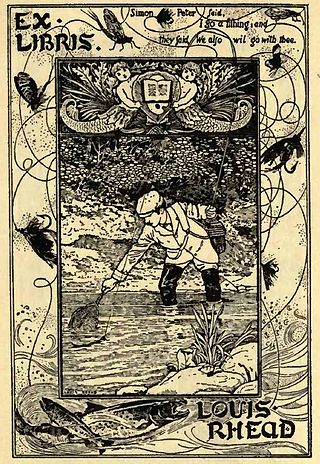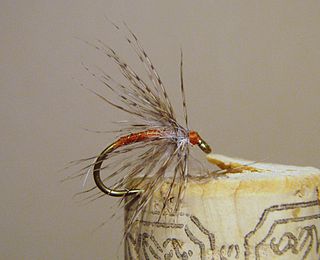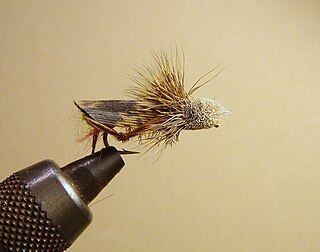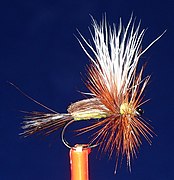
Fly fishing is an angling technique that uses an ultra-lightweight lure called an artificial fly, which typically mimics small invertebrates such as flying and aquatic insects to attract and catch fish. Because the mass of the fly lure is insufficient to overcome air resistance, it cannot be launched far using conventional gears and techniques, so specialized tackles are used instead and the casting techniques are significantly different from other forms of angling. It is also very common for the angler to wear waders, carry a hand net, and stand in the water when fishing.

Fly tying is the process of producing an artificial fly used by fly fishing anglers to catch fish. Fly tying is a manual process done by a single individual using hand tools and a variety of natural and manmade materials that are attached to a hook. Although the recent history of fly tying dates from the middle 1800s, fly tyers were engaged in tying flys since at least 200 AD.

The Woolly Bugger is an artificial fly commonly categorized as a wet fly or streamer and is fished under the water surface. It is a popular and widely used pattern for both freshwater and saltwater game fish and is generally listed as one of the top patterns to have in any fly box. John Gierach, a noted fly fishing writer discussed the Woolly Bugger first in his chapter on streamers in Good Flies. Woolly Buggers are typically fished in streams, rivers, ponds, lakes, and tidal flats. Today, Woolly Buggers are tied in a wide variety of styles and colors to imitate a wide range of game fish prey.
The Woolly Bugger is so effective, it should be banned from some watersheds. I suspect its effectiveness is due to its resemblance to so many edible creatures in the water—nymphs, leeches, salamanders, or even small sculpins. Its tail undulating behind a fiber, bubble-filled body is just too much for most fish to resist. It just looks like a meal!
Dry fly fishing is an angling technique in which the lure is an artificial fly which floats on the surface of the water and does not sink below it. Developed originally for trout fly fishing.

An artificial fly or fly lure is a type of fishing lure, usually used in the sport of fly fishing. In general, artificial flies are an imitation of aquatic insects that are natural food of the target fish species the fly fishers try to catch. Artificial flies are constructed by fly tying, in which furs, feathers, thread or any of very many other materials are tied onto a fish hook.

This general annotated bibliography page provides an overview of notable and not so notable works in the English language regarding the sport of fly fishing, listed by year of first publication. Although not all the listed books are devoted exclusively to fly fishing, all these titles contain significant fly fishing content. The focus of the present page is on classic general texts on fly fishing and its history, together with notable public or university library collections dedicated to fly fishing.

The Partridge and Orange is an artificial fly commonly categorized as a wet fly or soft hackle and is fished under the water surface. The fly is a very well known fly with its roots set firmly in English angling history. It is an impressionistic pattern fished successfully during caddis hatches and spinner falls. The Partridge and Orange is traditionally a trout and grayling pattern but may be used for other aquatic insect feeding species.

The Royal Coachman is an artificial fly that has been tied as a wet fly, dry fly and streamer pattern. Today, the Royal Coachman and its variations are tied mostly as dry flies and fished floating on the water surface. It is a popular and widely used pattern for freshwater game fish, particularly trout and grayling. Large streamer versions are also used for winter steelhead and Atlantic salmon.

This annotated bibliography is intended to list both notable and not so notable works of English language, non-fiction and fiction related to the sport of fly fishing listed by year published. Although 100% of any book listed is not necessarily devoted to fly fishing, all these titles have significant fly fishing content. Included in this bibliography is a list of fly tying, fly tackle, regional guides, memoirs, stories and fly fishing fiction related literature.

The Elk Hair Caddis is a dry fly commonly used for trout fishing. The Elk Hair Caddis was created by Pennsylvania fly tyer Al Troth in 1957. He is considered a pioneer in the sport of fly fishing for this invention.

The Royal Wulff is a popular artificial fly used for dry fly fishing. It is an attractor pattern and a descendant of both the Royal Coachman fly and the Wulff style of hair wing flies named for Lee Wulff.

The Adams is a traditional dry fly primarily used for trout. It is considered a general imitation of an adult mayfly, flying caddis or midge. It was designed by Leonard Halladay from Mayfield, Michigan in 1922, at the request of his friend Charles Adams. The Adams has been considered one of the most popular, versatile, effective and best selling dry flies since its creation.

Bunyan Bugs are a series of artificial lures used in fly-fishing, designed to look like a wide variety of insects, including grasshoppers, stoneflies, Mayflies, horse flies, bumble bees, ants and caddisflies.

Dave's Hopper is an artificial fly used for fly fishing, designed to imitate adult grasshoppers and other Orthoptera species. It is considered a dry fly terrestrial pattern. It was designed by fly tyer and angler Dave Whitlock, and combines the best aspects of Joe's Hopper and Muddler Minnow patterns.

The Stimulator is a dry fly popularized by angler, fly tyer and author Randall Kaufmann to imitate large adult stoneflies.

The Sakasa Kebari or reverse-hackle fly, is an artificial fly most associated with the Japanese style of tenkara fishing but can be used in most freshwater fly fishing. The Sakasa Kebari is usually defined by firstly, its reverse hackle and secondly, by its simplicity as compared to western style flies. This fly was originally created to be used in the small, high gradient streams in Japan while fishing for native trout and char.

The Wulff series of dry flies evolved from a dry fly style conceived by angler Lee Wulff in the 1930s.

The Brown Bi-visible is an attractor style dry fly. The addition of light cream colored or white hackle at the front of the darker body made the Bi-visible easier for the angler to see on the water. Ray Bergman in his seminal 1952 work Trout gave the following credit to the Bi-visible pattern:
I gave Bivisible flies complete and indisputable credit. I believe that I even intimated they were the last word--the ultimate in dry flies. I was so sold on the Bivisibles for one complete season that if trout wouldn't take one, I figured they wouldn't take anything, and I was perfectly satisfied with this decision.

Bonefish fly patterns are a collection of artificial flies routinely used by fly anglers targeting various species of Bonefish. Bonefish frequent tidal sand and mudflats in tropical and sub-tropical latitudes to feed on benthic worms, fry, crustaceans, and mollusks. Bonefish have small mouths and most Bonefish flies are tied on size 4 to 8 saltwater fly hooks.

Terrestrial flies are a broad group of artificial flies used by fly anglers to imitate terrestrial insects that fall prey to fish in rivers, streams and lakes. Most typical are patterns imitating grasshoppers, crickets, ants, beetles, leaf hoppers, cicadas and moths.
This page is based on this
Wikipedia article Text is available under the
CC BY-SA 4.0 license; additional terms may apply.
Images, videos and audio are available under their respective licenses.
























